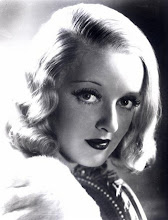The darkness and shadows that help define the film are largely the result of wartime restrictions, but the absence of available lighting was artfully turned into an opportunity to further explore the bleak tone of the narrative. The famous effect of venetian blinds casting shadows across the characters' faces suggests entrapment as they find themselves living in fear of having their crime discovered. The frosted glass in the office doors makes each character's shadow often the first and last part of them that the audience sees. It's even worked into the dialogue, as in the quote I used for the title of this post. The sense of darkness that pervades the film is more than just aesthetic; it's psychological, exposing the audience to the sense of hopelessness and claustrophobia that Phyllis and Walter feel in the aftermath of murdering Phyllis' husband.
The war had other effects on Double Indemnity's production as well. To avoid government censorship from the Office of War Information, the screenplay was set in July 1938, so it was not portraying the home front in a time of war. However, this created its own problems, as many props needed to make the set look realistically pre-war were unavailable at the time of filming due to rationing. This issue was most pressing in the scenes when Walter and Phyllis meet at the grocery store. To prevent cast and crew from making off with the canned goods, undercover federal agents patrolled the set, heightening the sense of paranoia already inherent in the movie's script.

Gender and sexuality are particularly strong themes throughout the film. Phyllis Dietrichson, ever the femme fatale, is introduced from a low angle, visually giving her power over Walter Neff right from their first meeting. The dialogue involving her anklet was created specifically to get their sexual tension past the censors; the result is a conversation laced with metaphor and innuendo, the first of several throughout the film. However, Phyllis' ownership of her sexuality does not come without a price. Although both main characters have dark sides, the woman is portrayed as more evil than the man, a common theme in hard-boiled stories such as this. In the end, both characters paid for their crimes with their lives as required by the Code, but Phyllis is the first to die, and Walter's shooting her can be seen as the first step in his redemption.
*Further information on Double Indemnity and its long struggle to gain approval from the Hays Office can be found in my professor's textbook, Blackout: World War II And The Origins Of Film Noir by Sheri Chinen Biesen



Very insightful! I never realized that about the rationing in the grocery scene store (in fact I don't think I ever realized that this took place years before the film was made)
ReplyDeleteI'm always learning something new when I read your posts!! :)